Analysis of Air Pollution and Environmental Health in Australia
VerifiedAdded on 2022/09/08
|10
|2150
|16
Report
AI Summary
This report provides an in-depth analysis of air pollution as a critical environmental health issue in Australia. Utilizing the DPSEEA framework, the report identifies driving forces, pressures, state changes, exposure, and effects of air pollution, emphasizing its detrimental impact on public health. It examines the roles of existing health agencies, stakeholders, legislative bodies, and regulatory bodies in managing and controlling air pollution, highlighting strategies and measures implemented in Australia. The study underscores the need for health risk assessments to effectively identify and manage air pollution, concluding that the issue is precarious and requires systematic and comprehensive approaches. The report also touches upon the impact of urbanization, industrial emissions, and climate change on air quality, and suggests policy recommendations, such as economic subsidies for industries to invest in pollution-reducing equipment, to address the identified gaps in current regulations.
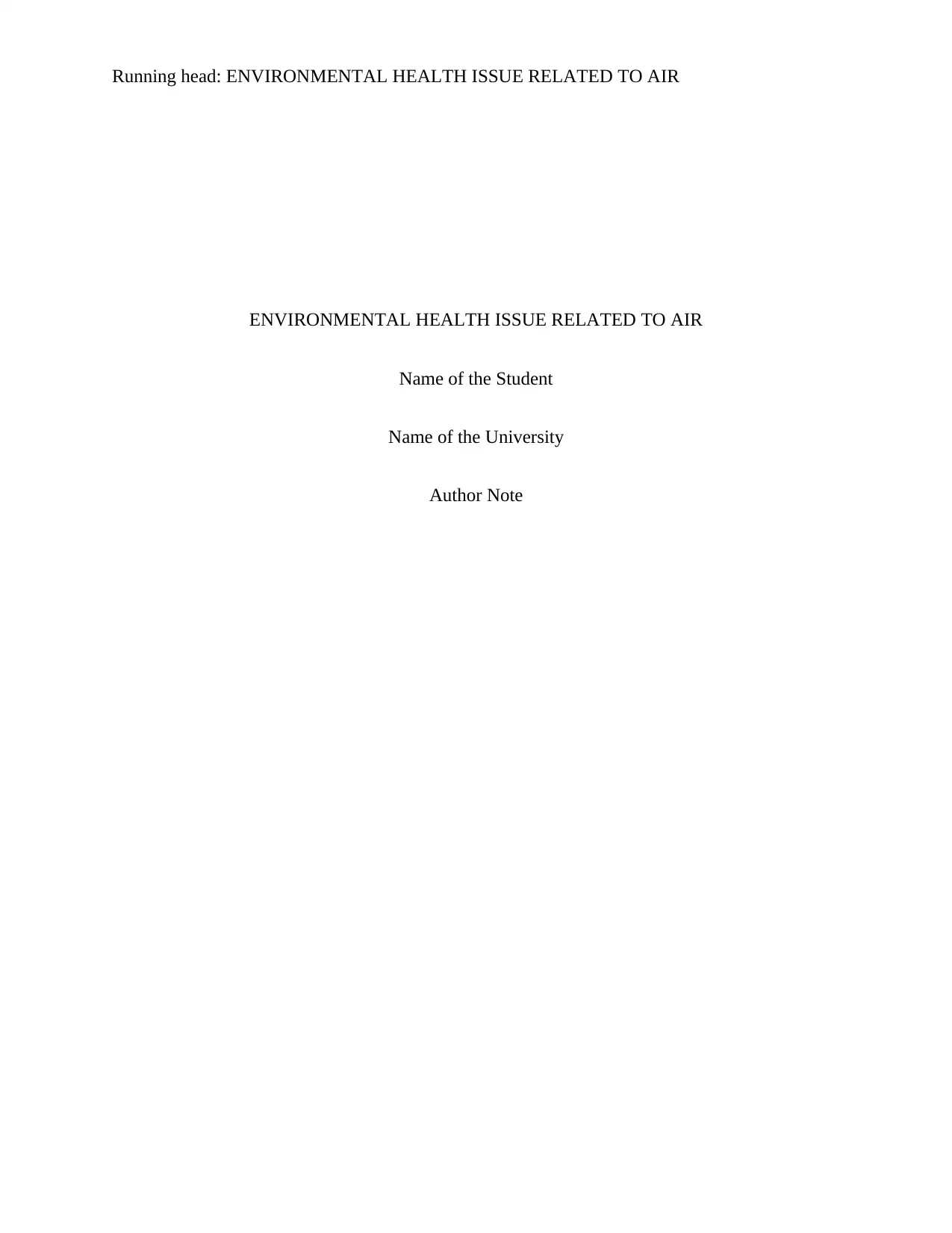
Running head: ENVIRONMENTAL HEALTH ISSUE RELATED TO AIR
ENVIRONMENTAL HEALTH ISSUE RELATED TO AIR
Name of the Student
Name of the University
Author Note
ENVIRONMENTAL HEALTH ISSUE RELATED TO AIR
Name of the Student
Name of the University
Author Note
Paraphrase This Document
Need a fresh take? Get an instant paraphrase of this document with our AI Paraphraser
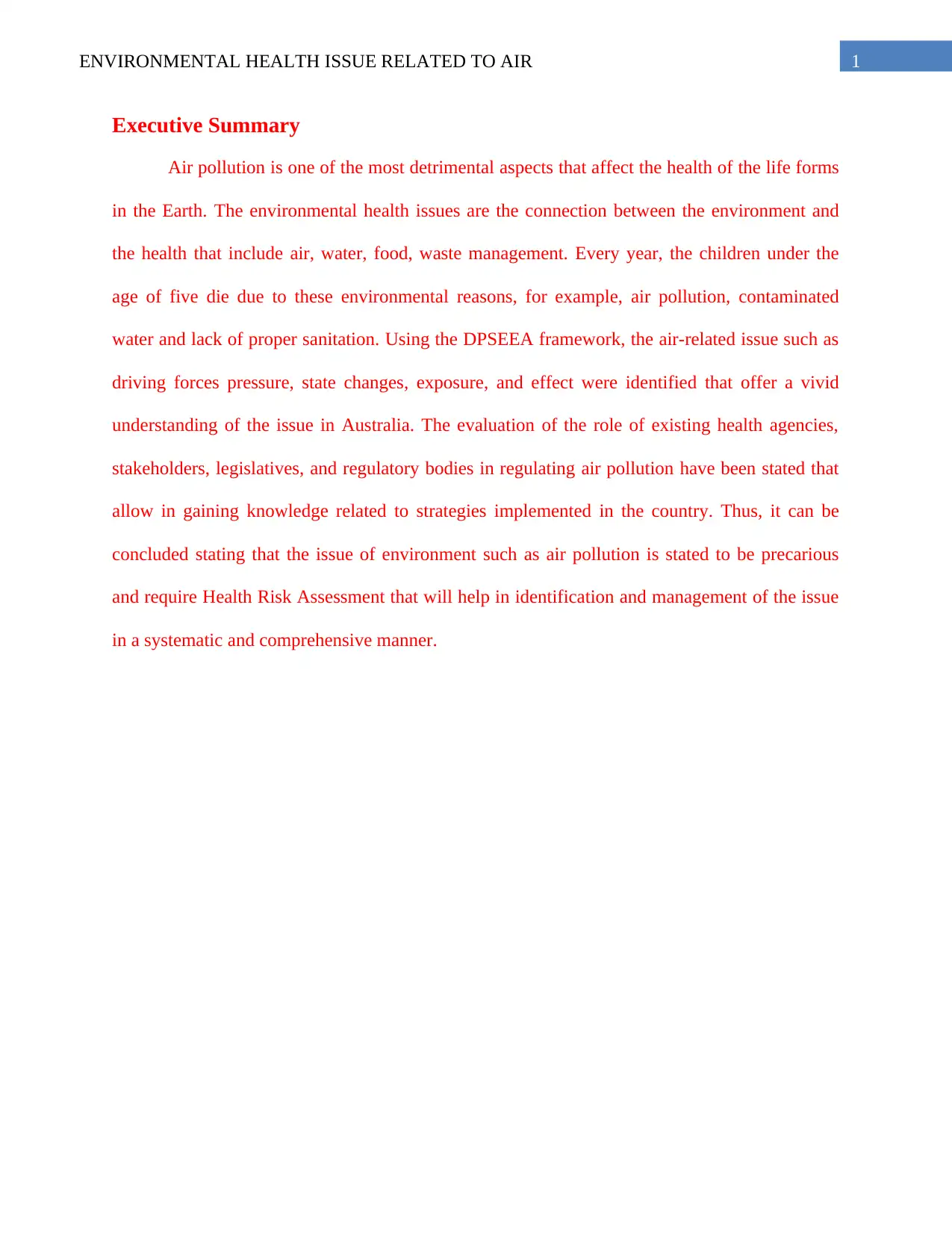
1ENVIRONMENTAL HEALTH ISSUE RELATED TO AIR
Executive Summary
Air pollution is one of the most detrimental aspects that affect the health of the life forms
in the Earth. The environmental health issues are the connection between the environment and
the health that include air, water, food, waste management. Every year, the children under the
age of five die due to these environmental reasons, for example, air pollution, contaminated
water and lack of proper sanitation. Using the DPSEEA framework, the air-related issue such as
driving forces pressure, state changes, exposure, and effect were identified that offer a vivid
understanding of the issue in Australia. The evaluation of the role of existing health agencies,
stakeholders, legislatives, and regulatory bodies in regulating air pollution have been stated that
allow in gaining knowledge related to strategies implemented in the country. Thus, it can be
concluded stating that the issue of environment such as air pollution is stated to be precarious
and require Health Risk Assessment that will help in identification and management of the issue
in a systematic and comprehensive manner.
Executive Summary
Air pollution is one of the most detrimental aspects that affect the health of the life forms
in the Earth. The environmental health issues are the connection between the environment and
the health that include air, water, food, waste management. Every year, the children under the
age of five die due to these environmental reasons, for example, air pollution, contaminated
water and lack of proper sanitation. Using the DPSEEA framework, the air-related issue such as
driving forces pressure, state changes, exposure, and effect were identified that offer a vivid
understanding of the issue in Australia. The evaluation of the role of existing health agencies,
stakeholders, legislatives, and regulatory bodies in regulating air pollution have been stated that
allow in gaining knowledge related to strategies implemented in the country. Thus, it can be
concluded stating that the issue of environment such as air pollution is stated to be precarious
and require Health Risk Assessment that will help in identification and management of the issue
in a systematic and comprehensive manner.
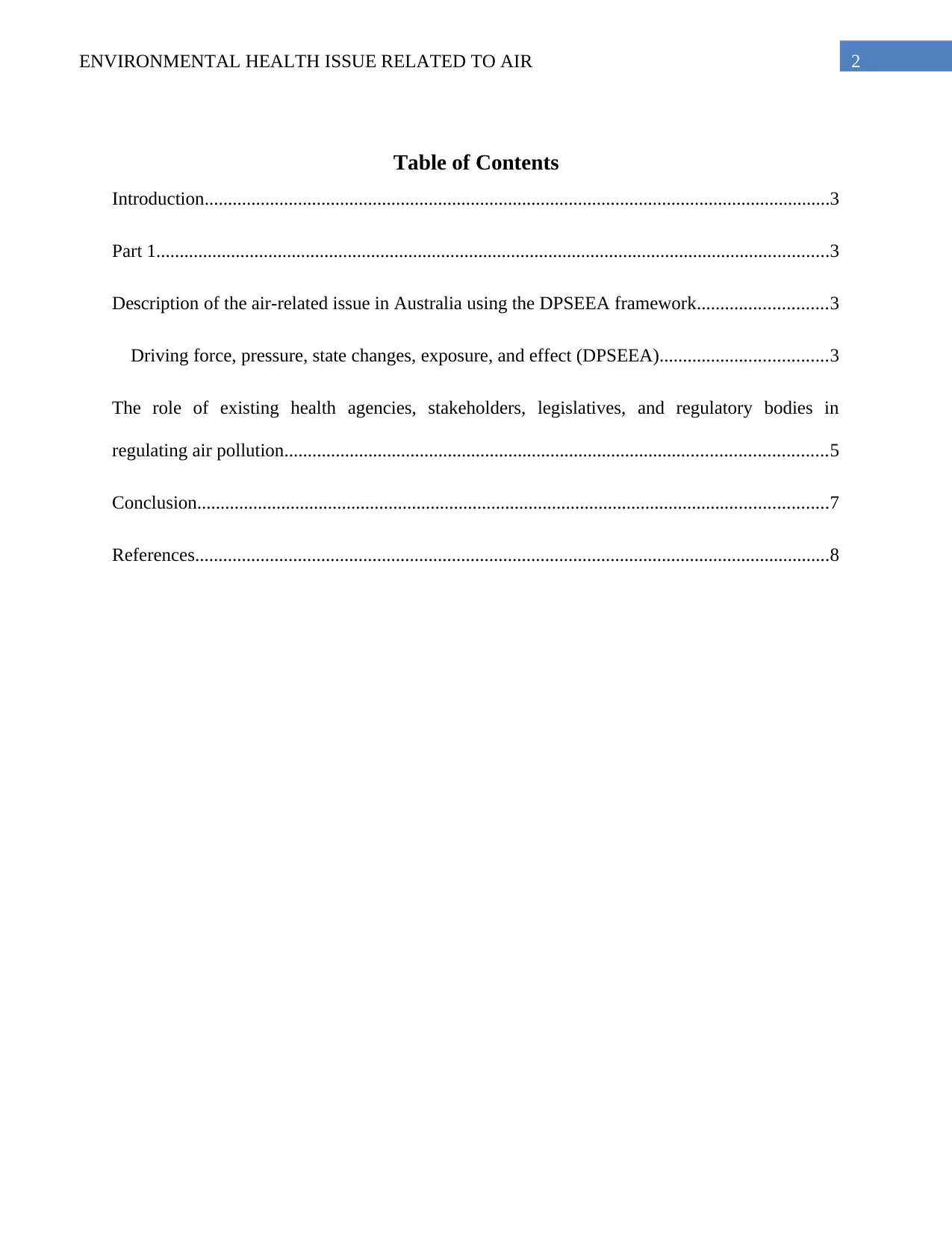
2ENVIRONMENTAL HEALTH ISSUE RELATED TO AIR
Table of Contents
Introduction......................................................................................................................................3
Part 1................................................................................................................................................3
Description of the air-related issue in Australia using the DPSEEA framework............................3
Driving force, pressure, state changes, exposure, and effect (DPSEEA)....................................3
The role of existing health agencies, stakeholders, legislatives, and regulatory bodies in
regulating air pollution....................................................................................................................5
Conclusion.......................................................................................................................................7
References........................................................................................................................................8
Table of Contents
Introduction......................................................................................................................................3
Part 1................................................................................................................................................3
Description of the air-related issue in Australia using the DPSEEA framework............................3
Driving force, pressure, state changes, exposure, and effect (DPSEEA)....................................3
The role of existing health agencies, stakeholders, legislatives, and regulatory bodies in
regulating air pollution....................................................................................................................5
Conclusion.......................................................................................................................................7
References........................................................................................................................................8
⊘ This is a preview!⊘
Do you want full access?
Subscribe today to unlock all pages.

Trusted by 1+ million students worldwide
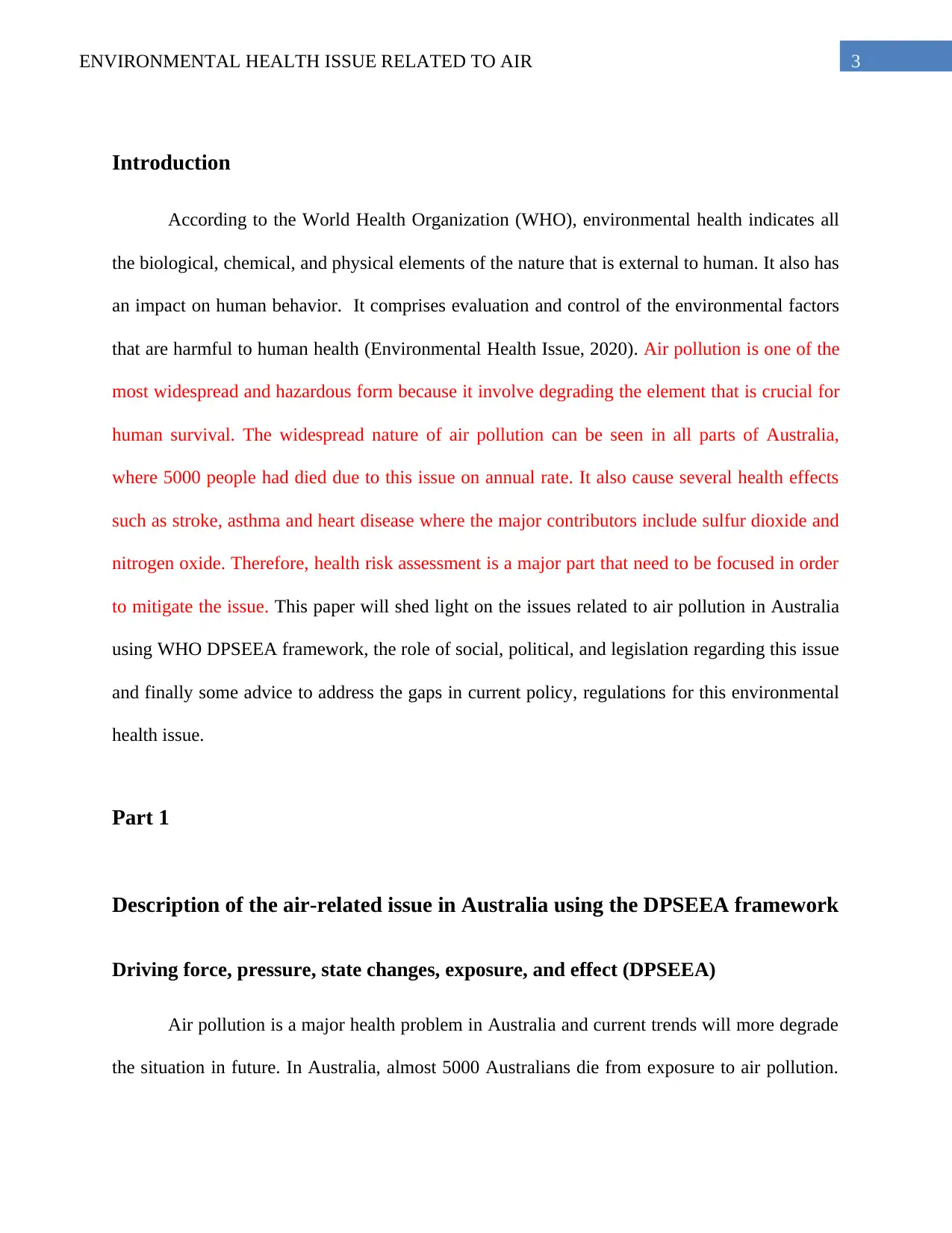
3ENVIRONMENTAL HEALTH ISSUE RELATED TO AIR
Introduction
According to the World Health Organization (WHO), environmental health indicates all
the biological, chemical, and physical elements of the nature that is external to human. It also has
an impact on human behavior. It comprises evaluation and control of the environmental factors
that are harmful to human health (Environmental Health Issue, 2020). Air pollution is one of the
most widespread and hazardous form because it involve degrading the element that is crucial for
human survival. The widespread nature of air pollution can be seen in all parts of Australia,
where 5000 people had died due to this issue on annual rate. It also cause several health effects
such as stroke, asthma and heart disease where the major contributors include sulfur dioxide and
nitrogen oxide. Therefore, health risk assessment is a major part that need to be focused in order
to mitigate the issue. This paper will shed light on the issues related to air pollution in Australia
using WHO DPSEEA framework, the role of social, political, and legislation regarding this issue
and finally some advice to address the gaps in current policy, regulations for this environmental
health issue.
Part 1
Description of the air-related issue in Australia using the DPSEEA framework
Driving force, pressure, state changes, exposure, and effect (DPSEEA)
Air pollution is a major health problem in Australia and current trends will more degrade
the situation in future. In Australia, almost 5000 Australians die from exposure to air pollution.
Introduction
According to the World Health Organization (WHO), environmental health indicates all
the biological, chemical, and physical elements of the nature that is external to human. It also has
an impact on human behavior. It comprises evaluation and control of the environmental factors
that are harmful to human health (Environmental Health Issue, 2020). Air pollution is one of the
most widespread and hazardous form because it involve degrading the element that is crucial for
human survival. The widespread nature of air pollution can be seen in all parts of Australia,
where 5000 people had died due to this issue on annual rate. It also cause several health effects
such as stroke, asthma and heart disease where the major contributors include sulfur dioxide and
nitrogen oxide. Therefore, health risk assessment is a major part that need to be focused in order
to mitigate the issue. This paper will shed light on the issues related to air pollution in Australia
using WHO DPSEEA framework, the role of social, political, and legislation regarding this issue
and finally some advice to address the gaps in current policy, regulations for this environmental
health issue.
Part 1
Description of the air-related issue in Australia using the DPSEEA framework
Driving force, pressure, state changes, exposure, and effect (DPSEEA)
Air pollution is a major health problem in Australia and current trends will more degrade
the situation in future. In Australia, almost 5000 Australians die from exposure to air pollution.
Paraphrase This Document
Need a fresh take? Get an instant paraphrase of this document with our AI Paraphraser
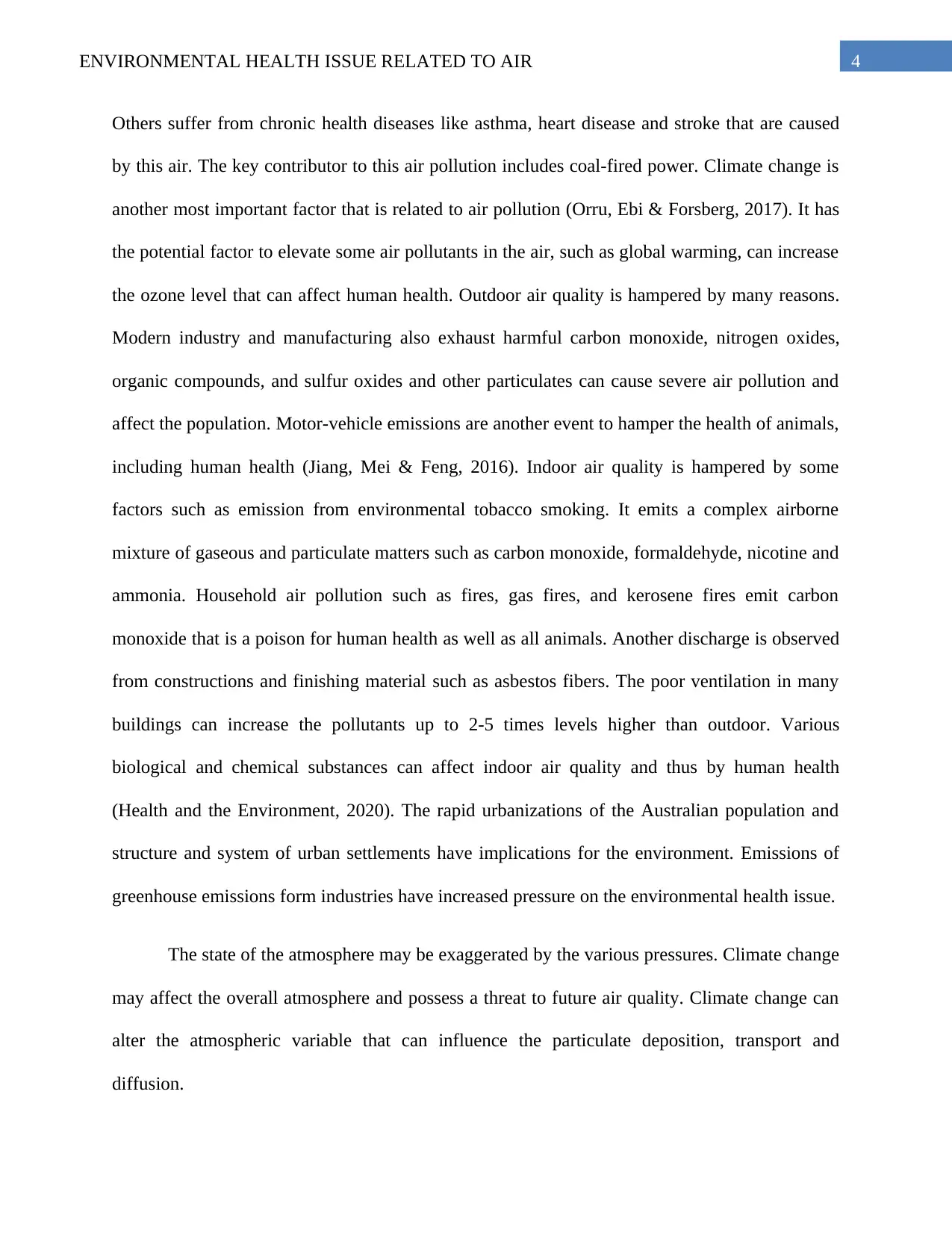
4ENVIRONMENTAL HEALTH ISSUE RELATED TO AIR
Others suffer from chronic health diseases like asthma, heart disease and stroke that are caused
by this air. The key contributor to this air pollution includes coal-fired power. Climate change is
another most important factor that is related to air pollution (Orru, Ebi & Forsberg, 2017). It has
the potential factor to elevate some air pollutants in the air, such as global warming, can increase
the ozone level that can affect human health. Outdoor air quality is hampered by many reasons.
Modern industry and manufacturing also exhaust harmful carbon monoxide, nitrogen oxides,
organic compounds, and sulfur oxides and other particulates can cause severe air pollution and
affect the population. Motor-vehicle emissions are another event to hamper the health of animals,
including human health (Jiang, Mei & Feng, 2016). Indoor air quality is hampered by some
factors such as emission from environmental tobacco smoking. It emits a complex airborne
mixture of gaseous and particulate matters such as carbon monoxide, formaldehyde, nicotine and
ammonia. Household air pollution such as fires, gas fires, and kerosene fires emit carbon
monoxide that is a poison for human health as well as all animals. Another discharge is observed
from constructions and finishing material such as asbestos fibers. The poor ventilation in many
buildings can increase the pollutants up to 2-5 times levels higher than outdoor. Various
biological and chemical substances can affect indoor air quality and thus by human health
(Health and the Environment, 2020). The rapid urbanizations of the Australian population and
structure and system of urban settlements have implications for the environment. Emissions of
greenhouse emissions form industries have increased pressure on the environmental health issue.
The state of the atmosphere may be exaggerated by the various pressures. Climate change
may affect the overall atmosphere and possess a threat to future air quality. Climate change can
alter the atmospheric variable that can influence the particulate deposition, transport and
diffusion.
Others suffer from chronic health diseases like asthma, heart disease and stroke that are caused
by this air. The key contributor to this air pollution includes coal-fired power. Climate change is
another most important factor that is related to air pollution (Orru, Ebi & Forsberg, 2017). It has
the potential factor to elevate some air pollutants in the air, such as global warming, can increase
the ozone level that can affect human health. Outdoor air quality is hampered by many reasons.
Modern industry and manufacturing also exhaust harmful carbon monoxide, nitrogen oxides,
organic compounds, and sulfur oxides and other particulates can cause severe air pollution and
affect the population. Motor-vehicle emissions are another event to hamper the health of animals,
including human health (Jiang, Mei & Feng, 2016). Indoor air quality is hampered by some
factors such as emission from environmental tobacco smoking. It emits a complex airborne
mixture of gaseous and particulate matters such as carbon monoxide, formaldehyde, nicotine and
ammonia. Household air pollution such as fires, gas fires, and kerosene fires emit carbon
monoxide that is a poison for human health as well as all animals. Another discharge is observed
from constructions and finishing material such as asbestos fibers. The poor ventilation in many
buildings can increase the pollutants up to 2-5 times levels higher than outdoor. Various
biological and chemical substances can affect indoor air quality and thus by human health
(Health and the Environment, 2020). The rapid urbanizations of the Australian population and
structure and system of urban settlements have implications for the environment. Emissions of
greenhouse emissions form industries have increased pressure on the environmental health issue.
The state of the atmosphere may be exaggerated by the various pressures. Climate change
may affect the overall atmosphere and possess a threat to future air quality. Climate change can
alter the atmospheric variable that can influence the particulate deposition, transport and
diffusion.
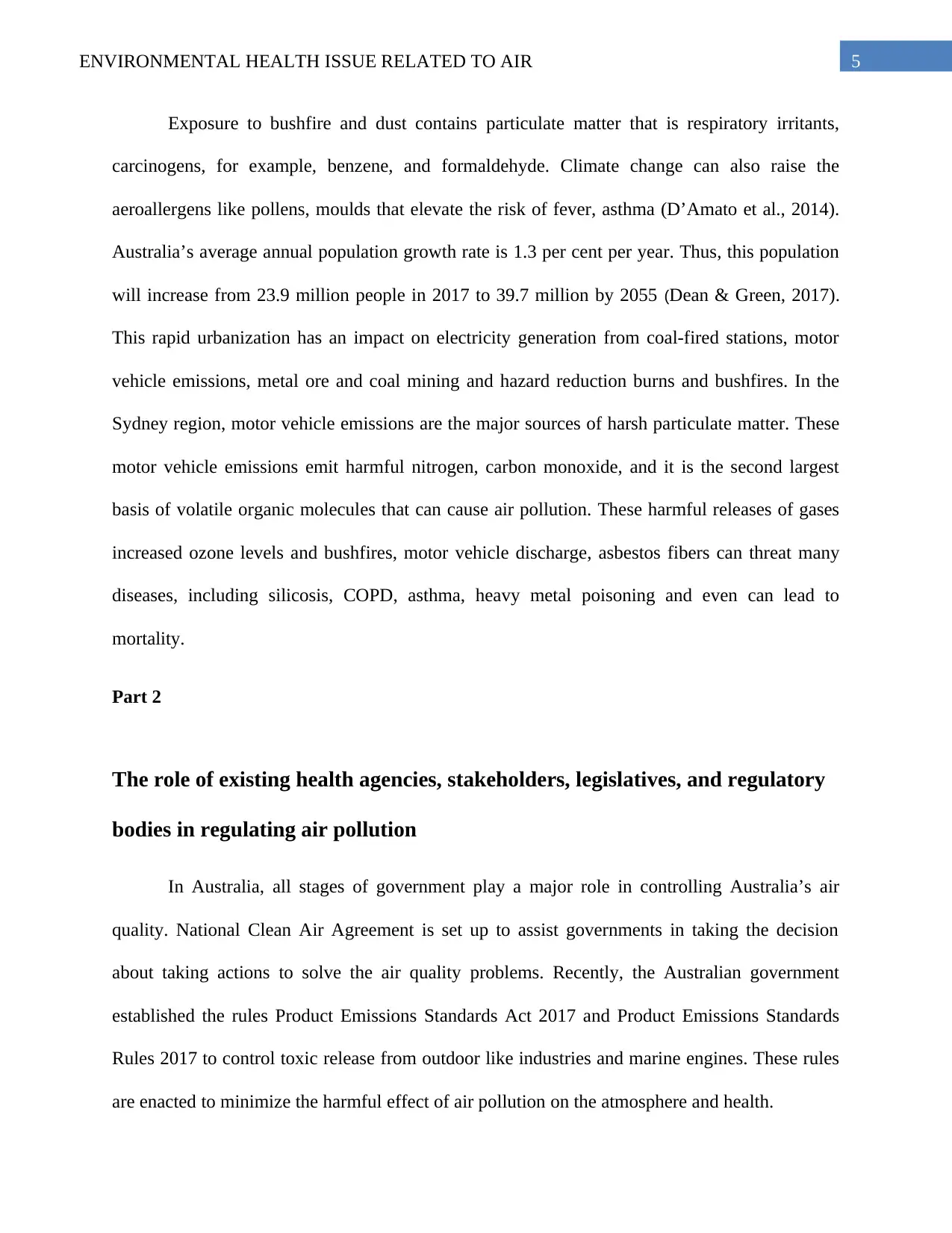
5ENVIRONMENTAL HEALTH ISSUE RELATED TO AIR
Exposure to bushfire and dust contains particulate matter that is respiratory irritants,
carcinogens, for example, benzene, and formaldehyde. Climate change can also raise the
aeroallergens like pollens, moulds that elevate the risk of fever, asthma (D’Amato et al., 2014).
Australia’s average annual population growth rate is 1.3 per cent per year. Thus, this population
will increase from 23.9 million people in 2017 to 39.7 million by 2055 (Dean & Green, 2017).
This rapid urbanization has an impact on electricity generation from coal-fired stations, motor
vehicle emissions, metal ore and coal mining and hazard reduction burns and bushfires. In the
Sydney region, motor vehicle emissions are the major sources of harsh particulate matter. These
motor vehicle emissions emit harmful nitrogen, carbon monoxide, and it is the second largest
basis of volatile organic molecules that can cause air pollution. These harmful releases of gases
increased ozone levels and bushfires, motor vehicle discharge, asbestos fibers can threat many
diseases, including silicosis, COPD, asthma, heavy metal poisoning and even can lead to
mortality.
Part 2
The role of existing health agencies, stakeholders, legislatives, and regulatory
bodies in regulating air pollution
In Australia, all stages of government play a major role in controlling Australia’s air
quality. National Clean Air Agreement is set up to assist governments in taking the decision
about taking actions to solve the air quality problems. Recently, the Australian government
established the rules Product Emissions Standards Act 2017 and Product Emissions Standards
Rules 2017 to control toxic release from outdoor like industries and marine engines. These rules
are enacted to minimize the harmful effect of air pollution on the atmosphere and health.
Exposure to bushfire and dust contains particulate matter that is respiratory irritants,
carcinogens, for example, benzene, and formaldehyde. Climate change can also raise the
aeroallergens like pollens, moulds that elevate the risk of fever, asthma (D’Amato et al., 2014).
Australia’s average annual population growth rate is 1.3 per cent per year. Thus, this population
will increase from 23.9 million people in 2017 to 39.7 million by 2055 (Dean & Green, 2017).
This rapid urbanization has an impact on electricity generation from coal-fired stations, motor
vehicle emissions, metal ore and coal mining and hazard reduction burns and bushfires. In the
Sydney region, motor vehicle emissions are the major sources of harsh particulate matter. These
motor vehicle emissions emit harmful nitrogen, carbon monoxide, and it is the second largest
basis of volatile organic molecules that can cause air pollution. These harmful releases of gases
increased ozone levels and bushfires, motor vehicle discharge, asbestos fibers can threat many
diseases, including silicosis, COPD, asthma, heavy metal poisoning and even can lead to
mortality.
Part 2
The role of existing health agencies, stakeholders, legislatives, and regulatory
bodies in regulating air pollution
In Australia, all stages of government play a major role in controlling Australia’s air
quality. National Clean Air Agreement is set up to assist governments in taking the decision
about taking actions to solve the air quality problems. Recently, the Australian government
established the rules Product Emissions Standards Act 2017 and Product Emissions Standards
Rules 2017 to control toxic release from outdoor like industries and marine engines. These rules
are enacted to minimize the harmful effect of air pollution on the atmosphere and health.
⊘ This is a preview!⊘
Do you want full access?
Subscribe today to unlock all pages.

Trusted by 1+ million students worldwide
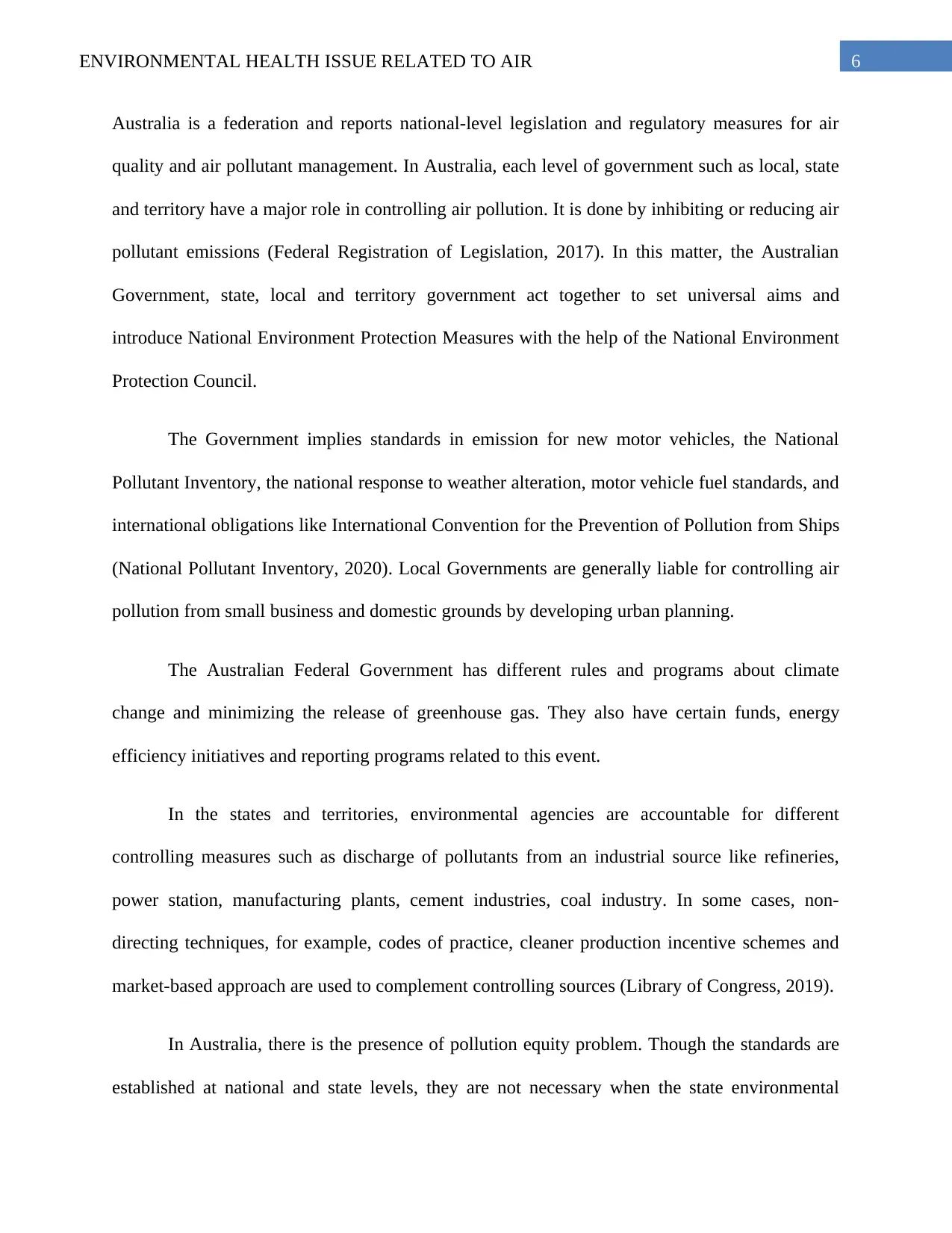
6ENVIRONMENTAL HEALTH ISSUE RELATED TO AIR
Australia is a federation and reports national-level legislation and regulatory measures for air
quality and air pollutant management. In Australia, each level of government such as local, state
and territory have a major role in controlling air pollution. It is done by inhibiting or reducing air
pollutant emissions (Federal Registration of Legislation, 2017). In this matter, the Australian
Government, state, local and territory government act together to set universal aims and
introduce National Environment Protection Measures with the help of the National Environment
Protection Council.
The Government implies standards in emission for new motor vehicles, the National
Pollutant Inventory, the national response to weather alteration, motor vehicle fuel standards, and
international obligations like International Convention for the Prevention of Pollution from Ships
(National Pollutant Inventory, 2020). Local Governments are generally liable for controlling air
pollution from small business and domestic grounds by developing urban planning.
The Australian Federal Government has different rules and programs about climate
change and minimizing the release of greenhouse gas. They also have certain funds, energy
efficiency initiatives and reporting programs related to this event.
In the states and territories, environmental agencies are accountable for different
controlling measures such as discharge of pollutants from an industrial source like refineries,
power station, manufacturing plants, cement industries, coal industry. In some cases, non-
directing techniques, for example, codes of practice, cleaner production incentive schemes and
market-based approach are used to complement controlling sources (Library of Congress, 2019).
In Australia, there is the presence of pollution equity problem. Though the standards are
established at national and state levels, they are not necessary when the state environmental
Australia is a federation and reports national-level legislation and regulatory measures for air
quality and air pollutant management. In Australia, each level of government such as local, state
and territory have a major role in controlling air pollution. It is done by inhibiting or reducing air
pollutant emissions (Federal Registration of Legislation, 2017). In this matter, the Australian
Government, state, local and territory government act together to set universal aims and
introduce National Environment Protection Measures with the help of the National Environment
Protection Council.
The Government implies standards in emission for new motor vehicles, the National
Pollutant Inventory, the national response to weather alteration, motor vehicle fuel standards, and
international obligations like International Convention for the Prevention of Pollution from Ships
(National Pollutant Inventory, 2020). Local Governments are generally liable for controlling air
pollution from small business and domestic grounds by developing urban planning.
The Australian Federal Government has different rules and programs about climate
change and minimizing the release of greenhouse gas. They also have certain funds, energy
efficiency initiatives and reporting programs related to this event.
In the states and territories, environmental agencies are accountable for different
controlling measures such as discharge of pollutants from an industrial source like refineries,
power station, manufacturing plants, cement industries, coal industry. In some cases, non-
directing techniques, for example, codes of practice, cleaner production incentive schemes and
market-based approach are used to complement controlling sources (Library of Congress, 2019).
In Australia, there is the presence of pollution equity problem. Though the standards are
established at national and state levels, they are not necessary when the state environmental
Paraphrase This Document
Need a fresh take? Get an instant paraphrase of this document with our AI Paraphraser
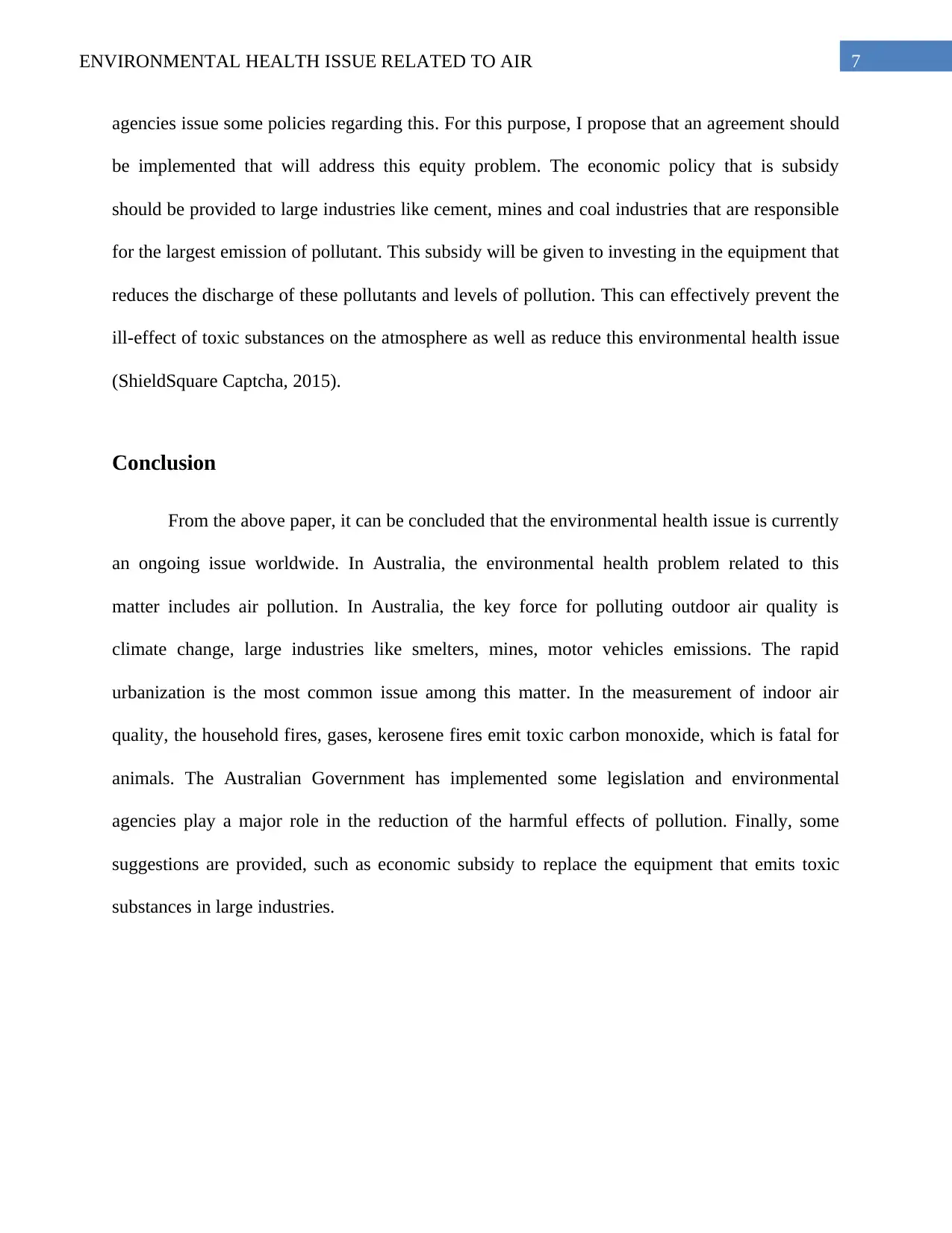
7ENVIRONMENTAL HEALTH ISSUE RELATED TO AIR
agencies issue some policies regarding this. For this purpose, I propose that an agreement should
be implemented that will address this equity problem. The economic policy that is subsidy
should be provided to large industries like cement, mines and coal industries that are responsible
for the largest emission of pollutant. This subsidy will be given to investing in the equipment that
reduces the discharge of these pollutants and levels of pollution. This can effectively prevent the
ill-effect of toxic substances on the atmosphere as well as reduce this environmental health issue
(ShieldSquare Captcha, 2015).
Conclusion
From the above paper, it can be concluded that the environmental health issue is currently
an ongoing issue worldwide. In Australia, the environmental health problem related to this
matter includes air pollution. In Australia, the key force for polluting outdoor air quality is
climate change, large industries like smelters, mines, motor vehicles emissions. The rapid
urbanization is the most common issue among this matter. In the measurement of indoor air
quality, the household fires, gases, kerosene fires emit toxic carbon monoxide, which is fatal for
animals. The Australian Government has implemented some legislation and environmental
agencies play a major role in the reduction of the harmful effects of pollution. Finally, some
suggestions are provided, such as economic subsidy to replace the equipment that emits toxic
substances in large industries.
agencies issue some policies regarding this. For this purpose, I propose that an agreement should
be implemented that will address this equity problem. The economic policy that is subsidy
should be provided to large industries like cement, mines and coal industries that are responsible
for the largest emission of pollutant. This subsidy will be given to investing in the equipment that
reduces the discharge of these pollutants and levels of pollution. This can effectively prevent the
ill-effect of toxic substances on the atmosphere as well as reduce this environmental health issue
(ShieldSquare Captcha, 2015).
Conclusion
From the above paper, it can be concluded that the environmental health issue is currently
an ongoing issue worldwide. In Australia, the environmental health problem related to this
matter includes air pollution. In Australia, the key force for polluting outdoor air quality is
climate change, large industries like smelters, mines, motor vehicles emissions. The rapid
urbanization is the most common issue among this matter. In the measurement of indoor air
quality, the household fires, gases, kerosene fires emit toxic carbon monoxide, which is fatal for
animals. The Australian Government has implemented some legislation and environmental
agencies play a major role in the reduction of the harmful effects of pollution. Finally, some
suggestions are provided, such as economic subsidy to replace the equipment that emits toxic
substances in large industries.
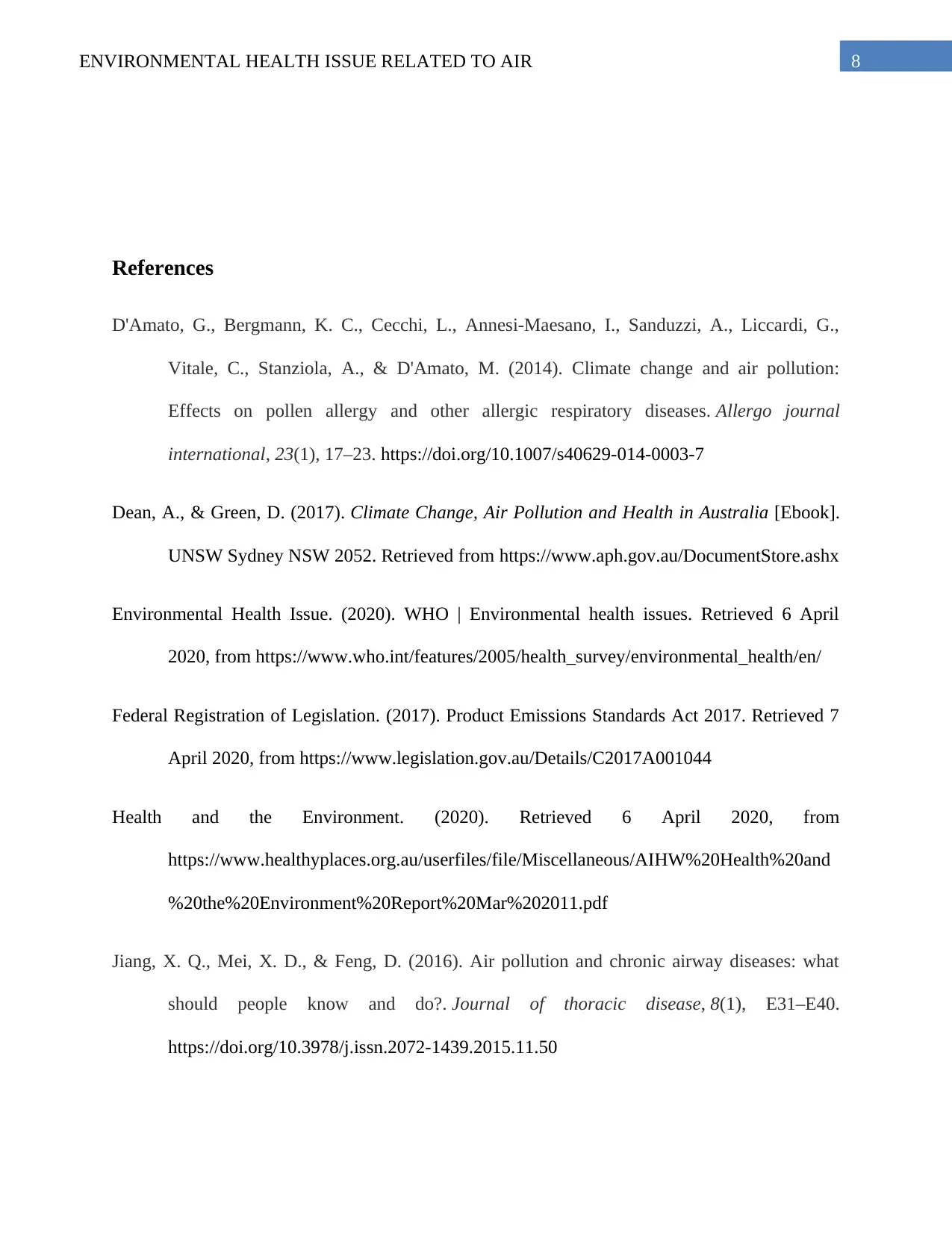
8ENVIRONMENTAL HEALTH ISSUE RELATED TO AIR
References
D'Amato, G., Bergmann, K. C., Cecchi, L., Annesi-Maesano, I., Sanduzzi, A., Liccardi, G.,
Vitale, C., Stanziola, A., & D'Amato, M. (2014). Climate change and air pollution:
Effects on pollen allergy and other allergic respiratory diseases. Allergo journal
international, 23(1), 17–23. https://doi.org/10.1007/s40629-014-0003-7
Dean, A., & Green, D. (2017). Climate Change, Air Pollution and Health in Australia [Ebook].
UNSW Sydney NSW 2052. Retrieved from https://www.aph.gov.au/DocumentStore.ashx
Environmental Health Issue. (2020). WHO | Environmental health issues. Retrieved 6 April
2020, from https://www.who.int/features/2005/health_survey/environmental_health/en/
Federal Registration of Legislation. (2017). Product Emissions Standards Act 2017. Retrieved 7
April 2020, from https://www.legislation.gov.au/Details/C2017A001044
Health and the Environment. (2020). Retrieved 6 April 2020, from
https://www.healthyplaces.org.au/userfiles/file/Miscellaneous/AIHW%20Health%20and
%20the%20Environment%20Report%20Mar%202011.pdf
Jiang, X. Q., Mei, X. D., & Feng, D. (2016). Air pollution and chronic airway diseases: what
should people know and do?. Journal of thoracic disease, 8(1), E31–E40.
https://doi.org/10.3978/j.issn.2072-1439.2015.11.50
References
D'Amato, G., Bergmann, K. C., Cecchi, L., Annesi-Maesano, I., Sanduzzi, A., Liccardi, G.,
Vitale, C., Stanziola, A., & D'Amato, M. (2014). Climate change and air pollution:
Effects on pollen allergy and other allergic respiratory diseases. Allergo journal
international, 23(1), 17–23. https://doi.org/10.1007/s40629-014-0003-7
Dean, A., & Green, D. (2017). Climate Change, Air Pollution and Health in Australia [Ebook].
UNSW Sydney NSW 2052. Retrieved from https://www.aph.gov.au/DocumentStore.ashx
Environmental Health Issue. (2020). WHO | Environmental health issues. Retrieved 6 April
2020, from https://www.who.int/features/2005/health_survey/environmental_health/en/
Federal Registration of Legislation. (2017). Product Emissions Standards Act 2017. Retrieved 7
April 2020, from https://www.legislation.gov.au/Details/C2017A001044
Health and the Environment. (2020). Retrieved 6 April 2020, from
https://www.healthyplaces.org.au/userfiles/file/Miscellaneous/AIHW%20Health%20and
%20the%20Environment%20Report%20Mar%202011.pdf
Jiang, X. Q., Mei, X. D., & Feng, D. (2016). Air pollution and chronic airway diseases: what
should people know and do?. Journal of thoracic disease, 8(1), E31–E40.
https://doi.org/10.3978/j.issn.2072-1439.2015.11.50
⊘ This is a preview!⊘
Do you want full access?
Subscribe today to unlock all pages.

Trusted by 1+ million students worldwide
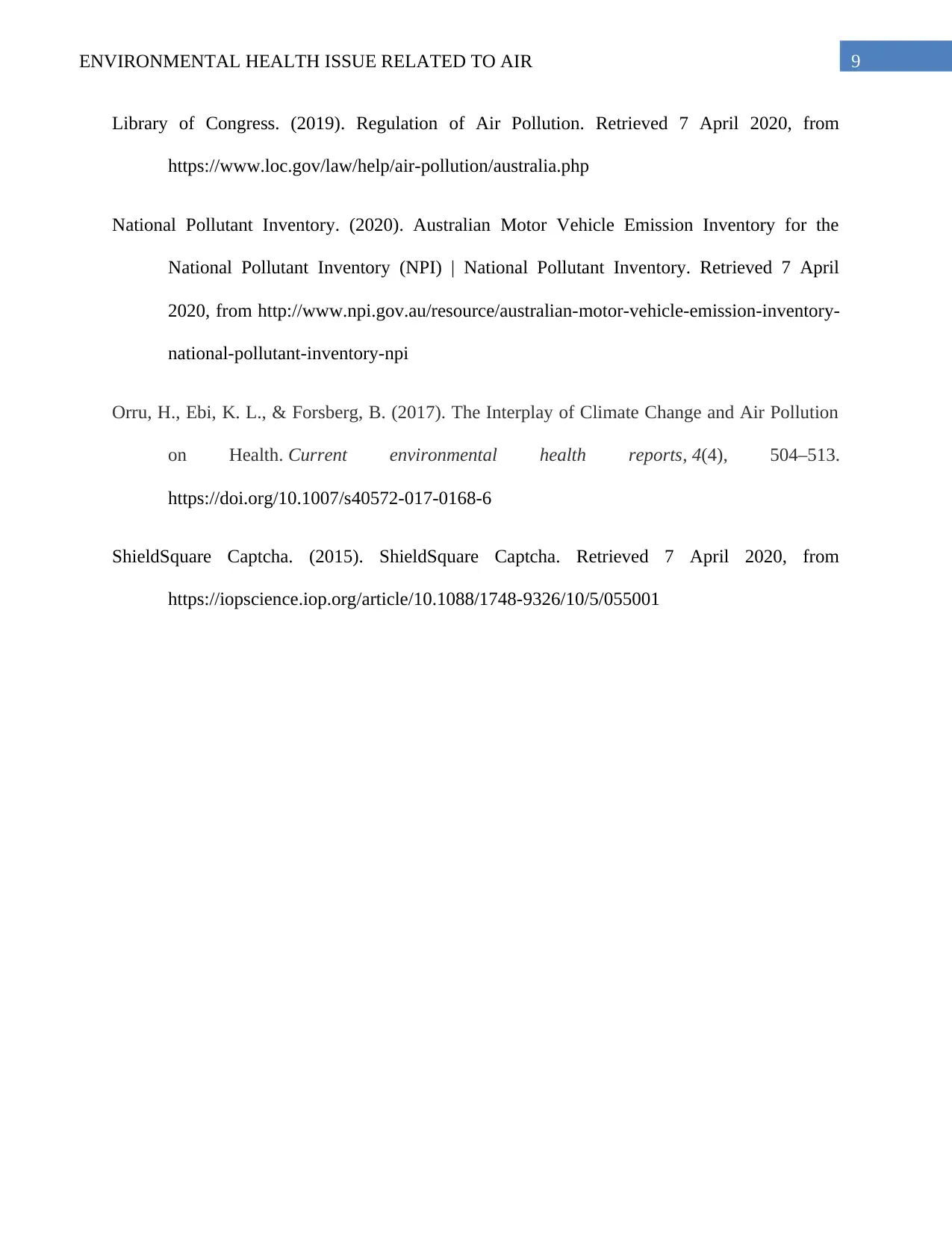
9ENVIRONMENTAL HEALTH ISSUE RELATED TO AIR
Library of Congress. (2019). Regulation of Air Pollution. Retrieved 7 April 2020, from
https://www.loc.gov/law/help/air-pollution/australia.php
National Pollutant Inventory. (2020). Australian Motor Vehicle Emission Inventory for the
National Pollutant Inventory (NPI) | National Pollutant Inventory. Retrieved 7 April
2020, from http://www.npi.gov.au/resource/australian-motor-vehicle-emission-inventory-
national-pollutant-inventory-npi
Orru, H., Ebi, K. L., & Forsberg, B. (2017). The Interplay of Climate Change and Air Pollution
on Health. Current environmental health reports, 4(4), 504–513.
https://doi.org/10.1007/s40572-017-0168-6
ShieldSquare Captcha. (2015). ShieldSquare Captcha. Retrieved 7 April 2020, from
https://iopscience.iop.org/article/10.1088/1748-9326/10/5/055001
Library of Congress. (2019). Regulation of Air Pollution. Retrieved 7 April 2020, from
https://www.loc.gov/law/help/air-pollution/australia.php
National Pollutant Inventory. (2020). Australian Motor Vehicle Emission Inventory for the
National Pollutant Inventory (NPI) | National Pollutant Inventory. Retrieved 7 April
2020, from http://www.npi.gov.au/resource/australian-motor-vehicle-emission-inventory-
national-pollutant-inventory-npi
Orru, H., Ebi, K. L., & Forsberg, B. (2017). The Interplay of Climate Change and Air Pollution
on Health. Current environmental health reports, 4(4), 504–513.
https://doi.org/10.1007/s40572-017-0168-6
ShieldSquare Captcha. (2015). ShieldSquare Captcha. Retrieved 7 April 2020, from
https://iopscience.iop.org/article/10.1088/1748-9326/10/5/055001
1 out of 10
Related Documents
Your All-in-One AI-Powered Toolkit for Academic Success.
+13062052269
info@desklib.com
Available 24*7 on WhatsApp / Email
![[object Object]](/_next/static/media/star-bottom.7253800d.svg)
Unlock your academic potential
Copyright © 2020–2025 A2Z Services. All Rights Reserved. Developed and managed by ZUCOL.





